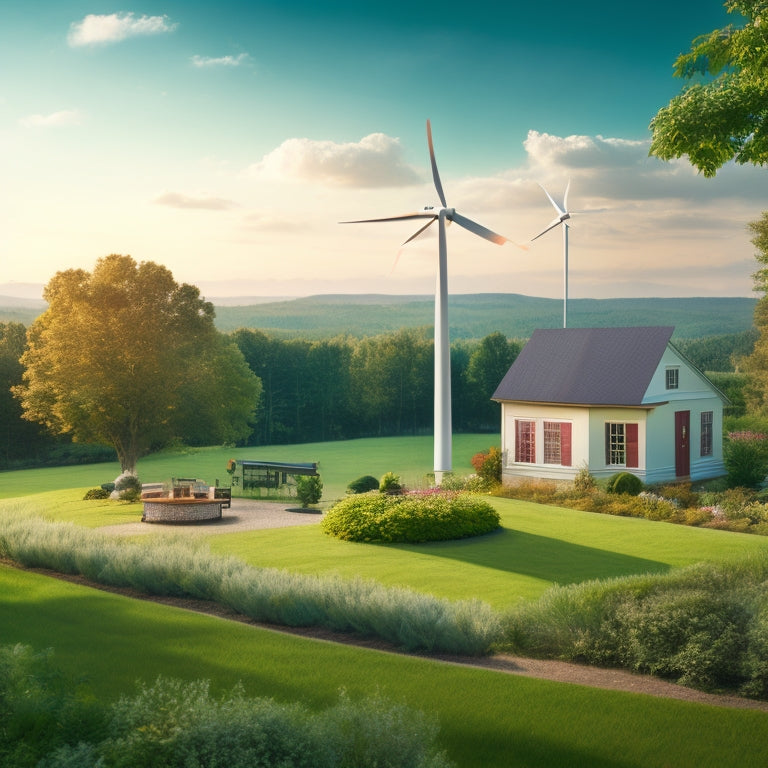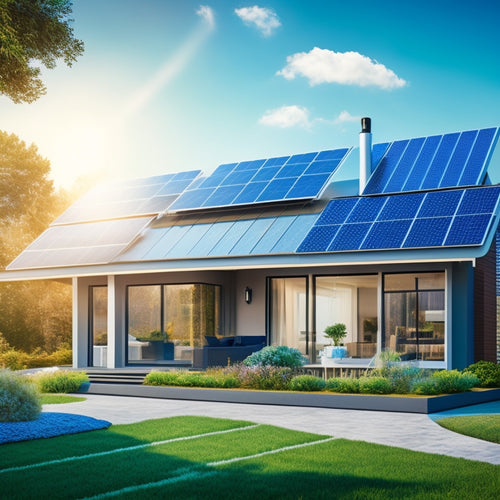
7 Best Home Wind Turbine Upkeep Tips for Homeowners
Share
As a homeowner with a wind turbine, you'll want to prioritize regular visual inspections to identify potential issues early, guaranteeing peak performance and lifespan extension. Don't forget to lubricate moving parts frequently, clean blades to maintain energy production efficiency, and check electrical connections regularly to prevent energy losses. Perform annual maintenance schedules, monitor turbine vibration levels, and replace worn-out parts promptly to avoid hazards. By following these 7 essential upkeep tips, you'll be well on your way to maximizing your wind turbine's potential - and there's more to investigate to guarantee your investment pays off in the long run.
Key Takeaways
- Conduct regular visual inspections during calm weather to identify potential issues early and ensure optimal turbine performance.
- Establish an annual maintenance schedule to inspect and clean blades, check tower and foundation integrity, and verify electrical connections.
- Lubricate moving parts, such as gearbox and blade bearings, every 3-6 months to maintain energy conversion efficiency.
- Monitor vibration data to detect irregularities in turbine rotation and predict maintenance needs, ensuring timely interventions.
- Document all inspections and repairs to track maintenance history and plan for periodic professional assessments for expert evaluations.
Regular Visual Inspections Matter
Your home wind turbine's towering presence is a demonstration of your commitment to renewable energy, but it's only as reliable as the maintenance it receives. Regular visual inspections are essential to guarantee ideal performance and extend its lifespan.
By adopting solar charging solutions, you can reduce your energy expenditure by up to 50% renewable energy source, making it a great complement to your wind turbine.
You should inspect your turbine regularly, ideally during periods of calm weather, to identify potential issues before they become major problems. Pay attention to the turbine's placement, confirming it's installed at an ideal distance from obstacles to maximize energy production.
Weather impact is also vital, as extreme weather conditions can affect your turbine's performance. Check for signs of wear, rust, or damage, and address any issues promptly to keep your turbine running efficiently and effectively.
Lubricate Moving Parts Frequently
The gearbox and blade bearings are the wind turbine's most vital moving parts, responsible for capturing kinetic energy and converting it into electrical power.
High-efficiency energy conversion, similar to high-efficiency solar panels, is essential for peak performance. You'll need to lubricate them frequently to guarantee peak performance and extend their lifespan.
Choose the right grease type for your turbine's specific needs, as some are designed for high-temperature or high-load applications.
As a general rule, lubricate moving parts every 3-6 months, depending on your turbine's usage and environmental conditions.
Be certain to follow the manufacturer's recommended lubrication frequency and guidelines to avoid over- or under-lubrication, which can lead to premature wear and damage.
Clean Blades for Optimal Performance
Regular lubrication is just one aspect of maintaining your home wind turbine's performance; another critical factor is the condition of the blades themselves.
Clean blades are essential for peak energy production, as dirt and debris can reduce efficiency by up to 25%. Additionally, solar-powered EV charging reduces carbon footprint and grid reliance, especially in rural areas, making it an attractive option for homeowners.
Fast charging solutions can also be beneficial for those with limited time for maintenance. To keep your blades in top shape, you'll need to clean them regularly.
- Inspect blade materials: Before cleaning, identify the type of material your blades are made of, as different materials require specific cleaning methods.
- Use gentle cleaning products: Avoid harsh chemicals or abrasive materials that can damage your blades.
- Clean in a controlled environment: Clean your blades in a controlled environment, such as a garage or indoor space, to prevent dirt and debris from spreading.
- Dry blades thoroughly: After cleaning, dry your blades thoroughly to prevent water spots and mineral deposits.
Check Electrical Connections Regularly
You'll want to regularly inspect the electrical connections in your home wind turbine to guarantee they're secure and functioning properly.
Loose connections can lead to energy losses, overheating, and even electrical fires, so make sure to tighten any screws or bolts that have worked loose over time.
Additionally, keep an eye out for worn-out wires, which can be a sign of impending failure and should be replaced promptly to prevent damage to your turbine.
Furthermore, proper electrical infrastructure is vital, as seen in solar-powered systems, and regular maintenance can help reduce energy costs and environmental impact.
Secure Loose Connections
Inspecting your home wind turbine's electrical connections regularly is vital to guaranteeing ideal performance and preventing potential hazards. Secure loose connections to avoid electrical shock, fires, or system failure.
During installation, it's important to follow best practices, assuring secure connections from the start. Installing EV charging stations, like those found in business parks, can also increase property value and attract eco-conscious tenants electrifying business parks.
Additionally, regular maintenance is key to long-term success, just as it's with EV charging infrastructure.
To secure loose connections, follow these steps:
- Tighten all electrical connections: Check for loose screws, nuts, or bolts, and tighten them according to the manufacturer's instructions.
- Inspect connectors and terminals: Look for signs of wear, corrosion, or damage, and replace them if necessary.
- Verify wire connections: Make sure wires are securely connected to the turbine, inverter, and other components.
- Perform routine maintenance: Schedule regular checks to catch potential issues before they become major problems.
Inspect Worn-Out Wires
Reliability hinges on the integrity of your home wind turbine's electrical system, and worn-out wires can be a silent saboteur. You must inspect your wires regularly to confirm they're not compromised.
Check for signs of wear, such as cracks, frays, or exposed copper. Inspect the wire insulation for damage or deterioration. A breach in the insulation can lead to electrical shocks, fires, or even a complete system failure.
Electrical safety is paramount, so don't take any chances. If you're unsure about what to look for or how to inspect the wires, consider consulting a professional.
Perform Annual Maintenance Schedules
Regular maintenance is key to guaranteeing your home wind turbine operates efficiently and effectively throughout its lifespan.
To achieve this, you should perform annual maintenance schedules to secure peak annual performance. Create a maintenance checklist to guide you through the process.
Here's a rundown of tasks to include in your schedule:
-
Inspect and clean the blades: Remove any debris that may affect efficiency.
-
Check the tower and foundation: Confirm the structure is secure and free from damage.
-
Lubricate moving parts: Apply lubricants to reduce wear and tear.
- Verify electrical connections: Ascertain all connections are secure and not damaged.
Monitor Turbine Vibration Levels
You'll need to regularly track vibration data to identify potential issues before they cause damage to your turbine.
This data will help you pinpoint irregularities in the turbine's rotation, which can indicate misalignment or worn components.
Vibration Data Tracking
Get into the habit of tracking vibration data to monitor turbine vibration levels, as this allows you to pinpoint potential issues before they escalate into costly problems.
Vibration analysis is essential for performance monitoring, and tracking data helps you identify anomalies that may indicate wear and tear, misalignment, or other issues.
Here's what you should track:
- Vibration amplitude: Measure the intensity of vibrations to detect unusual patterns.
- Frequency spectra: Analyze the frequency of vibrations to identify specific components that may be causing issues.
- Temperature data: Monitor temperature changes that can affect turbine performance and vibration levels.
- Trend analysis: Study vibration data over time to detect gradual changes that may indicate potential problems.
Turbine Balance Check
By analyzing vibration data, you've taken the first step in identifying potential issues with your home wind turbine.
Now, it's time to dig deeper with a turbine balance check. This vital step helps you pinpoint any imbalance in the turbine's rotor, which can lead to premature wear, reduced efficiency, and even catastrophic failure.
To perform a balance check, you'll need to assess the turbine's vibration levels under various operating conditions. Look for unusual patterns or anomalies that could indicate misalignment or imbalance.
If you detect any issues, it's important to conduct balance troubleshooting to identify the root cause. This might involve adjusting turbine alignment or replacing worn components.
Replace Worn-Out Parts Promptly
Regularly inspecting your home wind turbine's components can help identify worn-out parts that need replacement, preventing minor issues from escalating into major problems.
Replacing these parts promptly guarantees your turbine runs efficiently and safely.
Here are some vital parts to monitor and replace when necessary:
-
Blade bearings: Worn-out bearings can cause vibrations, noise, and decreased performance.
-
Generator brushes: Faulty brushes can lead to electrical issues and reduced power output.
-
Yaw and pitch system components: Malfunctioning yaw and pitch systems can affect turbine performance and safety.
- Anemometer components: Damaged anemometer parts can provide inaccurate wind speed readings, impacting turbine performance upgrades and safety precautions.
Frequently Asked Questions
Can I Install a Wind Turbine on a Rented Property?
Before installing a wind turbine on a rented property, you'll need to review your rental property agreements and familiarize yourself with local wind turbine regulations, ensuring you have permission from your landlord and compliance with zoning laws.
How Often Should I Inspect My Wind Turbine's Foundation?
As you gaze upon your wind turbine, remember the ancient Greeks' reverence for the wind gods; now, inspect your turbine's foundation at least quarterly to verify stability, lest it crumble like an Athenian temple, and perform annual thorough investigations to confirm its integrity.
What Is the Average Lifespan of a Home Wind Turbine?
You'll typically get 20-25 years of service from your home wind turbine, but turbine lifespan factors like maintenance frequency, quality of installation, and environmental conditions can greatly impact its overall durability and performance.
Can I Perform Maintenance Tasks on My Own?
You're the captain of your energy ship, steering through turbulent winds, and you're wondering if you can chart your own maintenance course. Yes, you can create a maintenance checklist and tackle DIY repairs, but be prepared to get hands-on with lubricants, bolts, and electrical systems.
Are There Any Noise Reduction Techniques for Wind Turbines?
You can minimize wind turbine noise by implementing noise dampening strategies, such as installing sound barriers or acoustic shielding around the tower, and optimizing blade design to reduce vortex noise generation.
Related Posts
-

3 Best Eco-Grants for Home Energy Upgrades
You're eligible for various eco-grants that can help you cut down on energy bills and reduce your carbon footprint by...
-

3 Ways Wind Power Boosts Home Value
Living near a wind farm can enhance your property's value in three significant ways. To begin with, proximity to wind...
-

7 Best Cool Roof Rebates for Energy-Savvy Homeowners
You're an energy-savvy homeowner looking to install a cool roof, and you're wondering which rebates can help you save...


